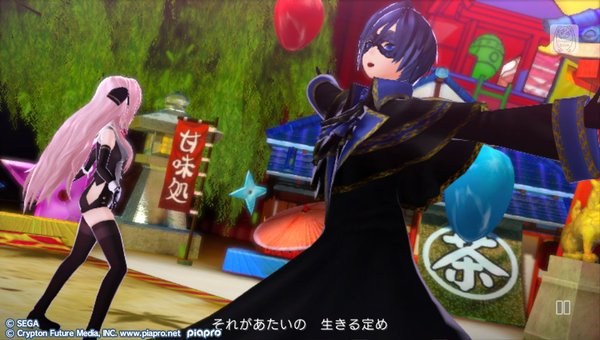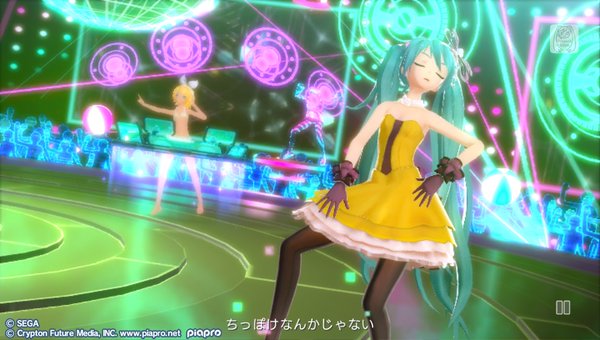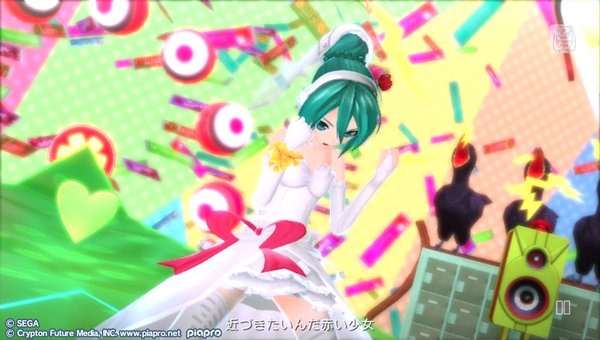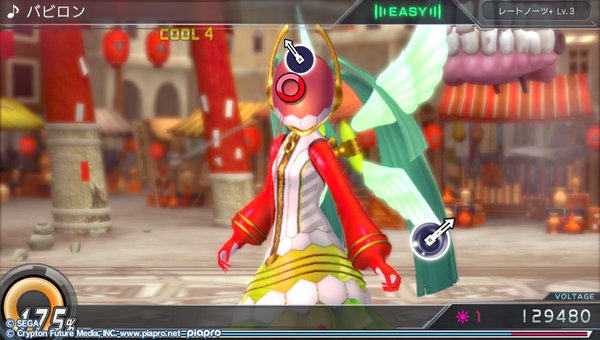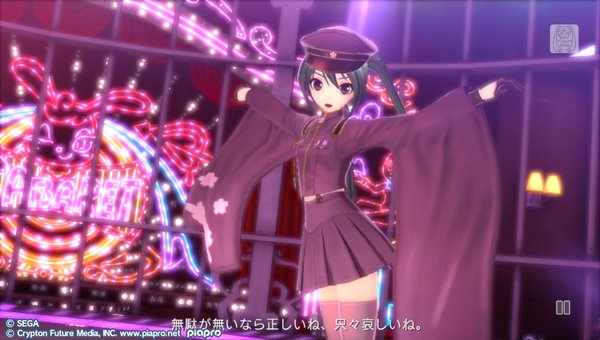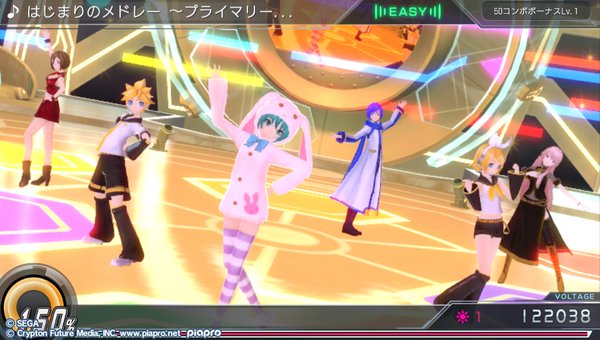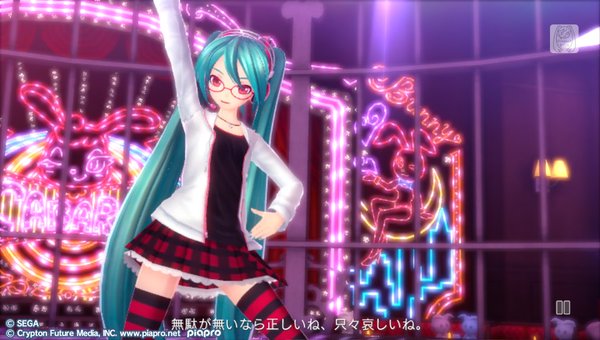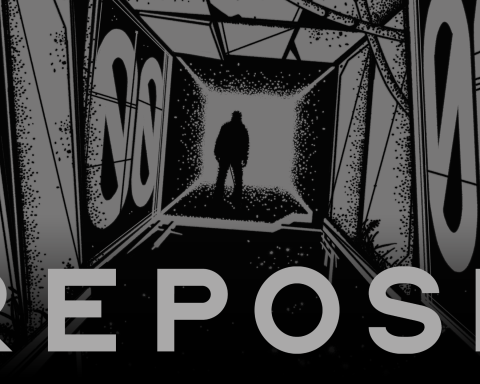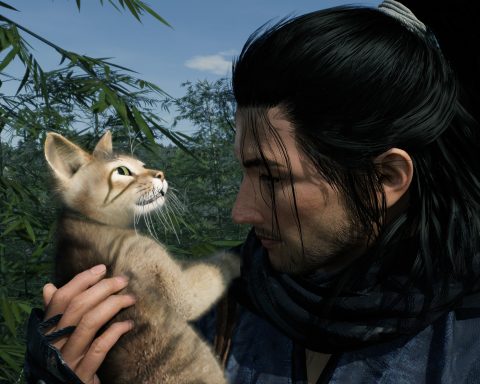Review by Matt S.
Miku’s back, baby, and she is oh-so-impossibly cute. Everyone who knows anything about me knows that I was always going to love Hatsune Miku: Project Diva X. That wasn’t ever going to be up for debate. And of course, I do love the game. I so do. The latest iteration of the franchise is more proof that SEGA was the right one to be given the task of growing Miku’s popularity globally through a series of rhythm games.
So, I really love this game. I love it a lot. That guy that married his copy of Love Plus has got nothing on how much I love Hatsune Miku. And I’m going to go absolutely ballistic (and at great length) in describing how much I love it in a moment. First, though, I’m going to start on a negative point (and I bet none of you expected that). So, bear with me a moment as I get my griping out of the way:
Why, oh why, did SEGA think it would be a good idea to stick a story mode in Project Diva X? I’ve pondered this a great deal since starting on the game, and the only explanation I can come up with is that the development team was frightened that if they did the exact same thing with this one as the previous games, the critics would slap it down a little for not being ‘innovative’ enough. And so, rather than risk the wrath of the critics, the team instead went scratching to introduce something here that we haven’t seen in Miku’s previous outings. Okay, fair enough. Fine. Let’s innovate. And in fairness to the developers, with most other arcade experiences building a story mode as that ‘innovation’ would actually make sense, because in helping to contextualise the experience via narrative, players can become more deeply involved in the action than if they could previously.
With Project Diva X, though, a story mode is a terrible idea. So here I am, a critic, and surely Miku’s biggest advocate in the press, slapping the game around a little. Ironic, no? My complaint is not that it is written poorly. From my very general understanding of Japanese, the bits of narrative that pop up between music tracks are simple and cute; it seems that it’s written well, but it’s clearly not a mind-blowing philosophical treatise, either. That’s not my issue with it. Rather, my issue with sticking a narrative into a Miku game is that in doing so SEGA’s management of the franchise has, for the first time, run contrary to the principles of Miku’s creator, Crypton.
Miku is meant to be a completely blank slate. She has a “look” and that heavenly voice, but that’s it. After designing her as a canvas, Crypton turned her over to the fans, and over the years the fans have done some amazing things with her based on their own interpretation of what they see in her. From the fan art, costume designs, enthusiast-developed music tracks, commercial music productions from people who have become minor celebrities in the sub-culture’s circles, right thought to the concerts and video clips that people have created for her in MikuMikuDance, just about everything we know about Miku comes from people who are at core fans of hers, and the reason that Miku is so incredible is because we see dozens, if not hundreds of visions of her. The games, for their part, have been incredible in showcasing the very best work that was being done with these fans and the canvas that is Hatsune Miku.
When I say that interpretations of Miku vary greatly, I’m not understating things. To some, Miku is the picture of innocence. To others she’s a quirky and fun tool to make quirky, silly music; a source of humour rather than a serious musical technology. Others see her potential for more traditional pop and even rock music. Yet another group has worked with Miku as a storytelling tool, complementary to or even independent of her music. And, yes, to address the point of contention that some seem to have with her; some do see her as a sexy anime girl. No person’s vision of Miku is wrong, and that’s the point. Crypton’s handling of the property across every pie that the IP has a thumb in (and these days, that’s a lot) has indulged every vision that a person might have of Hatsune Miku.
I saw it in motion myself when I was at the Miku Expo in Japan last year. Every version of Miku that I just outlined above was there on display in some meaningful way, and the event had an amazing, collaborative atmosphere as fans were mulling about, soaking in the wild kaleidoscope of content that their peers were instrumental in creating. I’d argue that Miku would never have become anywhere near as popular as she is today if there was some kind of “official” personality forced on her.
And what did SEGA do?
Project Diva X, as an official Miku product, has that pesky story mode that acts to give an “official” personality to Miku. Simple and functional as the story might be, it is nevertheless a project of characterisation. The six characters that participate in the narrative all have dialogue, ergo they have personalities that are thrust on players. And if you’re not on board with SEGA’s vision of who Miku is, then tough. No play for you; SEGA’s essentially telling you that everything that you’ve built Miku up to in your mind is wrong.
Instantly, the positive, powerful ideology of handing the character over to the fan has taken a hit, and a tiny part of the unsullied sheen of the character was lost. New players experiencing Miku for the first time through this game – and she’s a growing celebrity, so there will be plenty of those – are going to be especially affected, as they haven’t even had the chance to build their own vision of the character, but we are all effectively being asked to stop thinking so creatively about Miku, because SEGA’s now writing her for us. Now she’s less of an icon and more akin to a “normal” character.
Thankfully it’s possible to skip past the story sections. I’m still galled by the decision to put a narrative in there, because the very ideology behind it is sour, but don’t fear, folks, thanks to that skip button I’ve been able to ignore that story beyond checking it out enough to write this review, and so Miku is still my Miku in my mind.
Tappy tappy tappy
That’s the last of the complaints you’re going to hear from me regarding this game. The rest is all good. God it’s good. The core rhythm gameplay that has been the staple for the series across arcade and console for a few years now remains largely untouched. Little icons will fly across the screen in time with the music, and you’ll need to tap along in time with them lining up with icons that are static in the middle of the screen. Time it perfectly and you’ll get loads of points. Mistime it and you’ll feel terrible. The lyrics will even cut out on mistimed notes, a jarring reminder indeed on just how terrible your timing is.
While you’re tapping along with the lyrics (which can take some time to get used to, because the natural inclination in a rhythm game will be to synch with the bass and beat) a little music video clip will play in the background, showing Miku doing a very music pop-like dance routine. These music video clips have always been so appealing, as they are help to give the music character and charm; there have in fact been times I’ve not been particularly keen on a music track that I’ve listened to off one of my Miku music CDs, only to completely change my mind after seeing it accompanied by a music clip in a Miku game.
These clips are bright, colourful and filled with movement and energy, and are there more as a distraction than an enhancement to the gameplay. I’ve never done well on a track in any Miku game the first half dozen or so times I’ve tried it, regardless of difficulty level (which we’ll get to in a second). To put it simply, I’m usually too busy watching Miku dance to actually realise I’m missing icons. Thankfully it’s possible to change which character is performing in the background. Miku has five buddies that represent other characters in the Crypton stable – MEIKO, Kaito, Kagamine Rin and Len, and Megurine Luka, so after that half dozen tragic attempts and once I’ve reached the point where I want to actually score properly on a track, so I’ll jump into the options, switch Miku out for Kagamine Len or Luka, and be able to concentrate on the rhythm action from that point onwards (don’t yell at me, fans, I still like those two, but my eyes don’t decide they need to concentrate on them as I do the other four).
Project Diva games can be absolute time sinks for this reason. Once I’ve enjoyed the background clips themselves, I’ll start trying to score perfects on each of the four difficulty levels, with a perfect being an entire track of perfectly timed button presses. On Easy and Normal, that’s no challenge to me any longer (in saying that I’ve now spent over 1000 hours on the four previous Miku games I’ve played). On Hard and Extreme the perfects are… more difficult to achieve. I took around 340 hours to finally achieve all perfects on the last Project Diva game. It’s just as well I find the music appealing, but that really is a lot of gameplay. I’ve had years of experience in playing music, too, so in theory I should be predisposed to be good at these games, though in fairness I’m not sure if that’s a help or not because, as I noted previously, the icons in the Project Diva games marry with lyrics more than notes, and I’ve never been quite sure if my musical ear for beats is throwing me slightly there.
Regardless, the series has a reputation for being difficult for most people, and Project Diva X maintains the franchises’ edge. There have been a couple of slight tweaks to the gameplay, which I universally approve of, too. In the rhythm game itself there’s a new icon that asks you to mash a button quickly to build up points, which is a nice physical change of pacing within the action to the traditional single button presses and holds that we saw in previous titles.
Costumes are a big part of the Miku experience, as everyone likes dressing their characters up in their favourite costumes (ahem, bikini, ahem). In previous titles you would earn points by playing which could be used to unlock costumes that you had met the conditions to have the opportunity to unlock. It was as convoluted and messy as it sounds. In Diva X they are unlocked differently. Here you simply need to perform well in one particular part of a track. Do that and Miku will change costumes mid performance (get your minds out of the gutters; the screen fades to white as it happens), and appear back on screen wearing something different. If it’s a new costume you’ll be then able to dress her up in it from the start of a track. I really, really like this system. There’s no more need to play a track a dozen times while doing a naked rain dance and making animal sacrifices to the gods of music to finally convince the game to cough up a reward (the naked rain dance and sacrifices bit may or may not be completely optional and not actually part of the game, but boy were there hoops to jump through back in the day).
Related reading: What Miku can teach us about post-scarcity economics.
Miku is just plain gorgeous
You’ll want to unlock all the costumes, too, because they are stunning and a big part of Project Diva X’s creativity. Designed by fans, the variety in them ranges from the sexy, to the charming, to the plain weird, and Miku wears them all well. To take a break from actually playing the game, it’s possible to simply watch the routine as you would a video clip, so you can enjoy it stress free with your girl or guy wearing your favourite costume for him or her. SEGA has even thrown in the ability to pause the clips, which makes taking screenshots a snap.
On a purely visual level, this is the best Miku game to date. There have been obvious improvements in whatever technology is being used to actually create the routines (I don’t think it has ever been confirmed that the choreography in this game is done in MikuMiku Dance, but it wouldn’t surprise me). Where once Miku would move mechanically through set dance steps, now she smoothly transitions from one movement to the next, and she has a far greater range of figures to draw on. The result is more complex, nuanced dance routines, with an increasingly lifelike Miku relying less on childlike nonsense steps, and moving more like you might expect a professional performer to.
This matters, too. Where Miku’s always been expressive through her face and (obviously) voice, the actual physicality of her has taken some time to catch up. One of the things that most impressed me about her in the concert that I went to last year was the subtle realisms about her movement. When Miku made a jump and landed, for example, her foot would slide almost imperceptibly from the momentum; something that real dancers experience themselves. That her hair physics were rendered to the point that spot turns would have the hair “wrap” realistically was also beautiful to behold. The games are not quite to that standard yet, but they are getting there, and Miku X is certainly a step up over its predecessors. I can’t wait to see this thing on PlayStation 4.
One thing that I have found fascinating is the increasing conservatism that SEGA has shown towards more overt examples of fan service. Each of the Miku games in the past have prevented players from shifting the camera angle to a low perspective to look up any of the character’s skirts. But in the dance routines themselves there was often some pretty sexy movements going on. You’d get a good look at Miku’s underwear in Hm? Ah Yes, on the original Project Diva, for one example.
Project Diva X is the most restrained of the series to date in this regard. The odd fanservicey costume remains for people who like dressing Miku up in swimwear or wedding gowns missing the bottom half, and there are one or two music tracks that contain routines that feature similar sexy dance moves that we might see in pop music, but for the most part it’s really quite clear that Miku is going mainstream, and quickly, and if that means SEGA felt the need to shave off the more controversial edges, so be it. Gosh knows there’s enough fan art out there for people looking for Miku fanservice, and I do think it’s more suiting to the character that she’s something for everyone, rather than the niche anime otaku audiences. So well done to SEGA in this regard; I really can’t see anyone complaining about how Miku is presented in terms of sexualisation in Project Diva X.
It’s all about the music, baby
Of course, a rhythm game that didn’t offer very enjoyable music wouldn’t be much of a rhythm game. Project Diva X’s tracklist is possibly my favourite of all, though I’ve only plugged a fraction of the time in to this game that I have previous Miku titles, so that comes with the disclaimer that I have no idea if I’ll feel the same way another 200 hours down the track.
Of the 25 hours or so that I have played, however, my overwhelming impression is that this is the most mature, nuanced tracklist that we’ve seen from the series to date. There is still plenty of fun within it, of course, but the novelty tracks that we’ve seen in previous games, fun as they were, were a little out of tone with the mix of ballads, pop and pop-rock, and dance music that has become the standard genres for most Miku music. So their inclusion in the games led to some confusion about the inconsistency of the soundtrack in some quarters. That should be resolved here, even the novelty tracks are produced with a fidelity that means they’re not simply there for the laughs.
These tracks complement the improved nuance in Miku & co’s dance routines. With the vocaloid software itself maturing with each iteration, the work that producers are currently doing with it – and a lot of music from Diva X is relatively new – is also deeper, richer, and closer to the kind of thing that you would expect to see in “real” pop television.
Now, for some examples! My personal favourite is Hitorinbo Envy, where a dirty pop-style music track is paired with a breathy take on Miku’s vocaloid voice bank. Stick this track on, and get someone who doesn’t know better to listen in, and they’d assume that it’s a live artist trying to tap into the kind of performance style that Lady Gaga et al have been so successful with, though a little less bouncy and a little more smouldering. It’s a slick track, regardless, and one of the cleanest implementations of a vocaloid’s voice that I’ve encountered to date:
The track:
Chica de revolucion cerebral, meanwhile, has a jazzy, rocky vibe, with a fun “skipping” rhythm that really works in the context of a rhythm game. This is the kind of music where you’ll be tapping your feet in time with the buttons you’re pressing. I also think the music sits within Miku’s optimal vocal range. It’s high, but not shrill, and the clarity is superb.
The track:
The final of my personal top three from this particular game isn’t even a Hatsune Miku track (though of course I have Miku doing the performances in the video clip most of the time). No, this is a Kagamine Rin track, and while I’m not always a fan of her voice bank, there are moments where this voice bank really shines, and Rosuto Wan no Goukoku demonstrates that perfectly; it’s a belter of a rock song, and for a character that’s identifiably the youngest of the Cypton stable, boy does Rin have a pair of virtual lungs. Beneath the power-cording guitars, and speeding drum kit, her voice rolls through the lyrics, and it’s almost easy to be lulled into the sense that it’s a flat track. But then the chorus hits and kapows you awake. This is the most high energy and raw tracks in Project Diva X, and it makes for a heck of a rhythm game level.
The track:
The track list overall is a little thin in quantity when compared to the previous Miku games, where you’d be unlocking more and more music for what felt like went forever. It would be disappointing if there were weaknesses in the track list, but where in previous games I would feel like getting some perfects was a chore because I wasn’t so invested in the music that I actually wanted to play it over and over again, with this tracklist I can’t think of a single song that I won’t be enjoying four or five dozen attempts down the track.
One other touch that I really liked was the use of medleys, where Miku and crew preform remixed versions of more classic dance tunes that transition smoothly between three or so different pieces with each overall medley. As a guy who used to drive home from university very late at night, listening to disco medleys on the radio (because I’m cool like that), these tapped into a nostalgia that I really wasn’t expecting to get out of this game. The remixes are significant at times, to the point where you might struggle to figure out which tracks they’re based on, but they’re fun, the transitions are great, and the dancey vibe is spot on perfect.
Putting aside the story stuff, Project Diva X is an example of a rhythm game that gets absolutely everything right. The track list is deep, varied, and fun. The customisation options are extensive. There’s plenty of challenge and replay value. It might, ultimately, be a marginal iteration over its predecessors (story misfire aside), but when it comes to Miku, all I am looking for is steady refinement and new music tracks to play with. Keep it up, SEGA.
– Matt S.
Editor-in-Chief
Find me on Twitter: @digitallydownld


